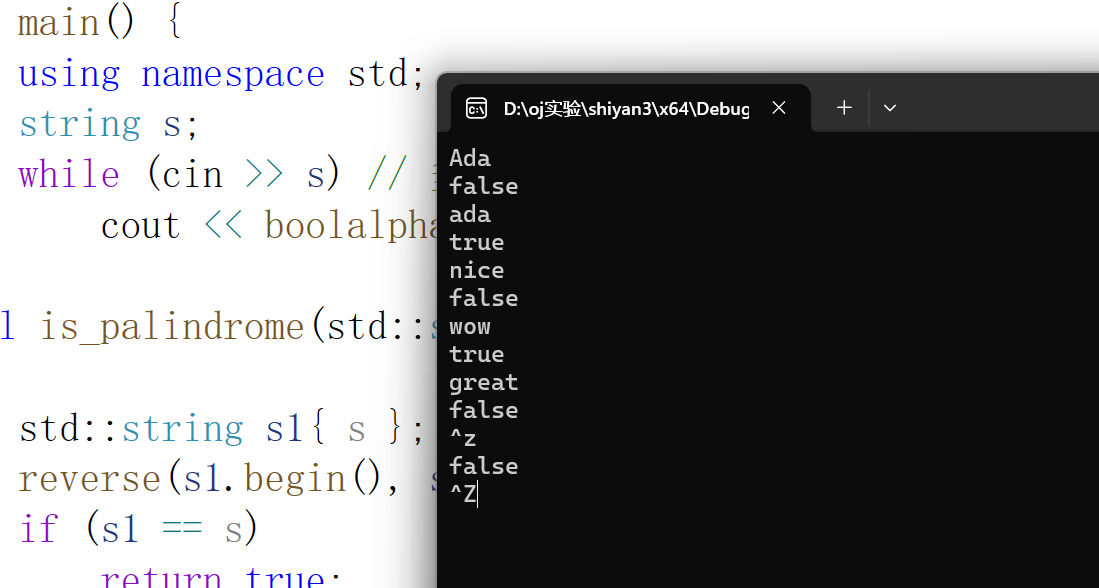实验1 现代c++初体验
任务1
// 现代C++标准库、算法库体验 // 本例用到以下内容: // 1. 字符串string, 动态数组容器类vector、迭代器 // 2. 算法库:反转元素次序、旋转元素 // 3. 函数模板、const引用作为形参 #include <iostream> #include <string> #include <vector> #include <algorithm> using namespace std; // 声明 // 模板函数声明 template<typename T> void output(const T& c); // 普通函数声明 void test1(); void test2(); void test3(); int main() { cout << "测试1: \n"; test1(); cout << "\n测试2: \n"; test2(); cout << "\n测试3: \n"; test3(); } // 函数实现 // 输出容器对象c中的元素 template <typename T> void output(const T& c) { for (auto& i : c) cout << i << " "; cout << endl; } // 测试1 // 组合使用算法库、迭代器、string反转字符串 void test1() { string s0{ "0123456789" }; cout << "s0 = " << s0 << endl; string s1{ s0 }; reverse(s1.begin(), s1.end()); // 反转指定迭代器区间的元素 cout << "s1 = " << s1 << endl; string s2{ s0 }; reverse_copy(s0.begin(), s0.end(), s2.begin()); // 将指定迭代区间的元素拷贝到指定迭代器开始的目标区间,并且在复制过程中反转次序 cout << "s2 = " << s2 << endl; } // 测试2 // 组合使用算法库、迭代器、vector反转动态数组对象vector内数据 void test2() { vector<int> v0{ 2, 0, 4, 9 }; cout << "v0: "; output(v0); vector<int> v1{ v0 }; reverse(v1.begin(), v1.end()); cout << "v1: "; output(v1); vector<int> v2{ v0 }; reverse_copy(v0.begin(), v0.end(), v2.begin()); cout << "v2: "; output(v2); } // 测试3 // 组合使用算法库、迭代器、vector实现元素旋转移位 void test3() { vector<int> v0{ 0, 1, 2, 3, 4, 5, 6, 7, 8, 9 }; cout << "v0: "; output(v0); vector<int> v1{ v0 }; rotate(v1.begin(), v1.begin() + 1, v1.end()); // 旋转指定迭代器区间[v1.begin(), v1.end())之间的数据项,旋转后从迭代器v1.begin() + 1位置的数据项开始 cout << "v1: "; output(v1); vector<int> v2{ v0 }; rotate(v2.begin(), v2.begin() + 2, v2.end()); cout << "v2: "; output(v2); vector<int> v3{ v0 }; rotate(v3.begin(), v3.end() - 1, v3.end()); cout << "v3: "; output(v3); vector<int> v4{ v0 }; rotate(v4.begin(), v4.end() - 2, v4.end()); cout << "v4: "; output(v4); }

任务2
#include <iostream> #include <vector> #include <string> #include <algorithm> #include <numeric> #include <iomanip> using namespace std; // 函数声明 // 模板函数声明 template<typename T> void output(const T& c); // 普通函数声明 int rand_int_100(); void test1(); void test2(); int main() { cout << "测试1: \n"; test1(); cout << "\n测试2: \n"; test2(); } // 函数实现 // 输出容器对象c中的元素 template <typename T> void output(const T & c) { for (auto& i : c) cout << i << " "; cout << endl; } // 返回[0, 100]区间内的一个随机整数 int rand_int_100() { return rand() % 101; } // 测试1 // 对容器类对象指定迭代器区间进行赋值、排序 void test1() { vector<int> v0(10); // 创建一个动态数组对象v0, 对象大小为10 generate(v0.begin(), v0.end(), rand_int_100); // 产生[0, 100]之间的随机整数赋值给指定迭代器区间[v0.begin(), v0.end())内的每个数据项 cout << "v0: "; output(v0); vector<int> v1{ v0 }; sort(v1.begin(), v1.end()); // 对指定迭代器区间[v1.begin(), v1.end())内数据项进行升序排序 cout << "v1: "; output(v1); vector<int> v2{ v0 }; sort(v2.begin() + 1, v2.end() - 1); // 对指定迭代器区间[v1.begin()+1,v1.end() - 1)内数据项进行升序排序 cout << "v2: "; output(v2); } // 测试2 // 对容器类对象指定迭代器区间进行赋值、计算最大值/最小值/均值 void test2() { vector<int> v0(10); generate(v0.begin(), v0.end(), rand_int_100); cout << "v0: "; output(v0); auto iter1 = min_element(v0.begin(), v0.end()); cout << "最小值: " << *iter1 << endl; auto iter2 = max_element(v0.begin(), v0.end()); cout << "最大值: " << *iter2 << endl; auto ans = minmax_element(v0.begin(), v0.end()); cout << "最小值: " << *(ans.first) << endl; cout << "最大值: " << *(ans.second) << endl; double avg1 = accumulate(v0.begin(), v0.end(), 0) / v0.size(); cout << "均值: " << fixed << setprecision(2) << avg1 << endl; cout << endl; vector<int> v1{ v0 }; cout << "v0: "; output(v0); sort(v1.begin(), v1.end()); double avg2 = accumulate(v1.begin() + 1, v1.end() - 1, 0) / (v1.size() - 2); cout << "去掉最大值、最小值之后,均值: " << avg2 << endl; }

任务3
#include <iostream> #include <string> #include <algorithm> bool is_palindrome(std::string s); int main() { using namespace std; string s; while (cin >> s) // 多组输入,直到按下Ctrl+Z后结束测试 cout << boolalpha << is_palindrome(s) << endl; } bool is_palindrome(std::string s) { std::string s1{ s }; reverse(s1.begin(), s1.end()); if (s1 == s) return true; else return false; }

任务4
#include <iostream> #include <string> #include <algorithm> std::string dec2n(int x, int n = 2); int main() { using namespace std; int x; while (cin >> x) { cout << "十进制: " << x << endl; cout << "二进制: " << dec2n(x) << endl; cout << "八进制: " << dec2n(x, 8) << endl; cout << "十六进制: " << dec2n(x, 16) << endl << endl; } } std::string dec2n(int x, int n) { std::string a = ""; if (x == 0) return "0"; while (x > 0) { int b = x % n; if (b < 10) { a = char(b + '0') + a; } else { a = char(b - 10 + 'A') + a; } x /= n; } return a; }

任务5
#include <iostream> #include<iomanip> int main() { std::cout << std::setw(2) << " "; for (int i = 97; i < 123; i++) { std::cout << std::setw(2) << char(i); } std::cout << std::endl; for (int i = 1; i <= 26; i++) { std::cout << std::setw(2) << i; for (char c = 'A'; c <= 'Z'; c++) { char en = (c - 'A' + i) % 26 + 'A'; std::cout << std::setw(2) << en << ""; } std::cout << std::endl; } return 0; }

任务6
#include <iostream> #include <cstdlib> #include <ctime> #include <iomanip> struct Problem { int operand1; int operand2; char operatorChar; int answer; }; int getRandomInt(int min, int max) { return rand() % (max - min + 1) + min; }




